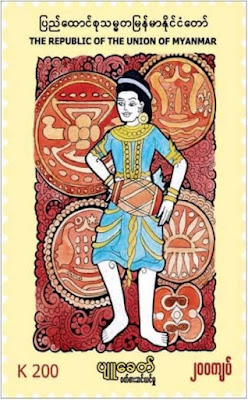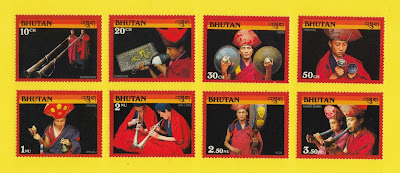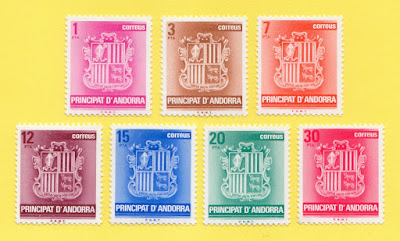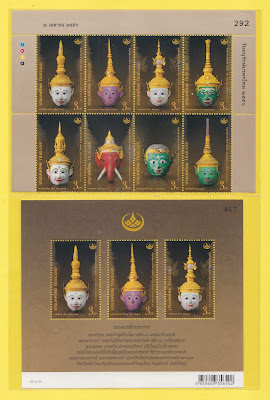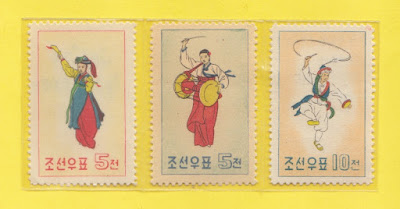Date of Issued: 04 April 2001
Perforation: 13¼
0.40 Tonga Seniti - Ma'ulu'ulu Dance
The māʻuluʻulu is a traditional Tongan dance, performed by a group of seated men and women; stylistically, the dance form is a direct successor of the ancient Tongan ʻotuhaka having been synthesized with the Samoan Māuluulu which was imported during the 19th century.
The performers sit down in a row on the ground, crosslegged, usually the right leg over the left. If possible men and women alternate. To the left and/or right is/are the nafa (see below), behind them stand the langituʻa, the singers. On informal occasions the dancemaster may walk around, clapping his hands to keep up the rhythm and to encourage the performers. On formal occasions, like a presentation to the king, the dancemaster also stands in the back. Only when the dancemaster is the chief Malukava, he is allowed per tradition to be in front.
If there are many dancers, often the case when a school performs, up to 500 at a really huge occasion, they sit in staggered rows. The dancers of front row (which gets the most attention and therefore sits the best dancers or the ones with the highest social status) sit on the ground. The second row on a low bench, the next row on a higher bench, and so forth. The last row usually stands, or if that is still not enough, they may stand on benches and tables. If the dance is an effort of a local community, young and old perform. The youngest children then cutely sit at the ends of the rows.
In the ʻUiha tradition the arrangement is different: the women sit on the ground in the frontrow(s) but the men stand behind them and act more as in a lakalaka.
Like the ʻotuhaka, the māʻuluʻulu consists usually of a sung and a silent part. It starts with the beating of the nafa, huge drums made from discarded 200 litre, iron, fuel drums, covered with a leather skin. The nafa-master can make a whole show of it, hitting the drums with his two decorated sticks almost performing a dance himself. Once he has calmed down and he, and his helpers have settled down in a continuous beating of the drums, the tafua starts. This is the silent part of the performance in which the dancers are performing all the typical haka (dance gestures) of the main dance, as whether they want to show them off before you would be distracted by the singing later. In semi-formal performances this is the moment that the public, which has become māfana (excited), can come forward to put fakapale on the dancers they fancy to be the best or close family. On really formal performances this is not allowed, on really informal performances, often fundraising, the fakapale goes on about for the whole dance, which unfortunately distracts a lot. When the tafua is over the nafa usually stops and singing starts. Like all other Tonga dances, the gestures do have some relationship with the words, but are largely symbolic. Like in the ʻotuhaka the haka are supposed to be performed close the body, haka nounou (short armed) as opposed to the lakalaka. However the Vavaʻu tradition allows much wilder and wider arm movements. The lyrics of the song is usually made for the occasion, praising the object into the skies. A silver jubilee of a school, a birthday of the king, and so on. The music is very limited. There are about 10 different tunes which can be used in a māʻuluʻulu, so that to the untrained ear they all sound much alike. Once the song is over another tafua follows. At this time the tempo of the dance has been increased feverishly, and so has the excitement of the public.
A māʻuluʻulu takes around 15 minutes to complete. But it may have taken the performers 2 or 3 months to memorise the sequence of gestures. For a school there are daily sessions at the end of the class hours, for a community it will fill all their free nights, often combined with a faikava.
0.55 Tonga Seniti - Meʻetuʻupaki Dance
The meʻetuʻupaki (meʻe tuʻu paki: dance standing [with] paddles) is an ancient Tongan group dance, already reported by early European navigators like captain Cook. This dance has been traditionally designed for men although women may take part if there are not enough men. The meʻe tuʻu paki resembles a kind of war dance; albeit, it is done with little symbolic paddles as opposed to arms.
The dress for this dance invariably is a large sheet of ngatu wrapped around the body from chest to ankles. A girdle of leaves around the waist (sisi) is often added.
The movements are largely with the paddles in the hand, but the proper addition of the small and subtle movements with the head and legs make the difference between a good and poor performance. The paddles are not used for row like gestures, but are rotated around, moved to left and right or up and down. The dancers start in one row, maybe two if there are many, but from time to time split up the rows in what seems chaotic movements, yet at the end they come back again in perfect unison.
It is usually the dance master who operates a little slit drum (lali) to keep the beat, while the dancers themselves sing the song, possibly with assistance of others. The beat is always slow in the beginning, but goes faster and faster when the end approaches to excite the dancers and the public.
The words of the songs are in a largely unintelligible language, although some sailor terms can be distinguished. As there is also a version of the meʻetuʻupaki in Futuna, called tapaki even though different, a link in that direction seems to be most likely. The theory is that the meʻetuʻupaki was composed somewhere in the 12th to 16th century by an internationally oriented poet on ʻUvea to honour the Tuʻi Tonga empire. When the Tuʻi Tonga Kauʻulufonua I (Kauulufenua-fekai, K. the wild, in Futunan) had lost some decisive battles, which heralded the end of the empire and of the political function of the Tuʻi Tonga, he was forced to give meʻetuʻupaki to Futuna, where the parts are still guarded as secrets. In addition the Futunans declared that from now on the Tuʻi Tonga title should be inferior to any Futunan title, and if ever a Tongan boat would make it to their island, it would be destroyed and offered to the gods. (This still happened in the 19th century as recorded by William Mariner (writer). A Tongan proverb: vete fakafutuna (take apart in the Futunan way), still refers to something to be dismantled completely.
There is also a theory that the meʻetuʻupaki was a kind of Tongan passport of olden times. When a boat from Tonga arrived on one of the conquered islands the crew was invited to show their typical dance to prove that they came from Tonga and not from somewhere else. As they then still had their paddles in their hand, using them in a dance seem quite straight forward.
0.80 Tonga Seniti - Tauʻolunga Dance
The tauʻolunga is a traditional Tongan dance. It is a combination of the Samoan Taualuga and the Tongan ula. The type of dance is comparable with (some) Hawaiʻian hula or the Tahitian ʻaparima.
The tau'olunga is a dance for single young women, especially for them to show off on their wedding day. It is rare--but not impossible--for a married couple or an older woman to do a tau'olunga. It is also rare to see a man perform the dance, but he can mimic the dancing girl's movements in an exaggerated manner to make her beauty more striking by comparison. Despite these rare cases, the tau'olunga can be danced at any special occasion. Often it is performed by a small group of girls, up to 10 or so, but can also be performed individually. The assistance of older women is usually limited to only handclaps on the rhythm of the music. This role is called the tuʻulafale.
It is usual for a girl to start the dance, then parents, cousins, family members or friends come on the stage to put money notes on her oiled skin, and then join her in the tuʻulafale. The prizemoney (fakapale) is a reward for the girl, unless, as often is the case, the dance is performed as part of a fundraising or for a special occasion. It is common for the money to go towards the person being celebrated. For birthdays, the money would go to the person whose birthday they are celebrating. For weddings, it will go to the wedding couple. For a graduation, it will go to the person graduating etc.
The tauʻolunga mainly consists of a series of hand movements, which interpret the meaning of the selected song. However, most of the movements are so stylised that only experienced practitioners will understand their meaning. Many of the typical gestures (haka) are standardised and have their own name. The movement of the head also plays a significant role: the head and eyes should follow the hands on important movements, otherwise they are to be directed to the public. The eyes are never to glance away from the viewers. From time to time, little nods within one beat (teki) or two beats (kalo) must be made with the head. The girl must smile throughout her performance.
The movements of the body and the legs are less important. They have to follow hands and head. Shaking the hips, as elsewhere in Polynesia, is forbidden. Most of the time the legs are standing still, knees must be together and bent (taulalo). Some small steps--never large--or a turn around can be performed. Overall, the girl's movements should be graceful and soft, as should be her whole body.
A unique feature of any Tongan dance, not found elsewhere in Polynesia, is the rotational movements of the hands and wrists in many of the haka.
A tauʻolunga girl is usually dressed in a wrap around dress, either made from ngatu with traditional designs; a mat (kie) from handwoven pandanus leaves; a piece of cloth covered with green leaves, grass, fragrant flowers or shells; any shiny piece of cloth, decorated with sewn-on traditional patterns; or even a grass skirt. Every type of costume (teunga) has its own proper name. The dress reaches from just above the breasts down to the knees (or sometimes past the knee), leaving her arms and legs bare. As long skirts are the traditional apparel for Tongan girls, this is an occasion to show off her legs. If they are fair, the better.
Putting oil on her exposed skin parts so that they shine enhances her beauty even more in the Tongan mind. Around her middle she wears a belt (kafa) also usually made from leaves and fragrant flowers. Wristlets and anklets (vesa) may be worn, ranging from simple bands of cloth or ngatu to elaborate belts of leaves and flowers again. Around her neck she wears a black ribbon with a white cowry shell on it or not (puleʻoto). On her head she wears a little crown (tekiteki), which will enhance her head movements during the dance, consisting of feathers or some light plant material.
The more natural materials are used for her whole dress the better it is. Unfortunately plastic is slowly making its inroads nowadays.
Many technical motifs of the tauʻolunga are derived from the ancient Tongan ula / faʻahi-ula / fahaʻiula. The original ula was a group dance of young chiefly daughters who, on the rhythm of a quite monotonous song, made a series of postures beautiful to look at. The formalization of the dance as a distinct genre followed the introduction of the Samoan "taualuga" during the early 19th century and its institution among Tongan aristocratic circles (especially those associated with the Tu'i Kanokupolu lineages). The postures originally emphasized finger and hand motifs (following Samoan stylistics), until 1950 when queen
Sālote personally integrated the distinctly Tongan wrist flourishes and lakalaka leg transitions into her song "Manu ʻo Palataisi" (Bird of Paradise), leading to the technical composition and format of the contemporary Tongan tauʻolunga.
2.70 Tonga Pa'anga - Faha'iula Dance
The ula (dance) is an ancient Tongan group dance, already reported by early European navigators like captain Cook. It is also known as fahaʻi-ula (split dance), which may be degenerated to fahaʻiula. Traditionally it is performed after an ʻotuhaka. It is still danced nowadays, although less popular than its descendant the tauʻolunga.
The name split dance comes from the habit that the performers split up in two (or more) groups, one entering the stage from the left, the other from the right
] until the two meet in the centre and merge into one or more rows. The performers are always girls, it is rare that boys will join.
The dance movements are in essence very simple and limited. Most of the work, making supple, beautiful posures, is done by the hands and the head. The body remains quite stiff, and except for an occasional step or a kneeling, the legs are not much used either.
The dress of the girls is like that of the tauʻolunga, although the red dress is here most popular.






